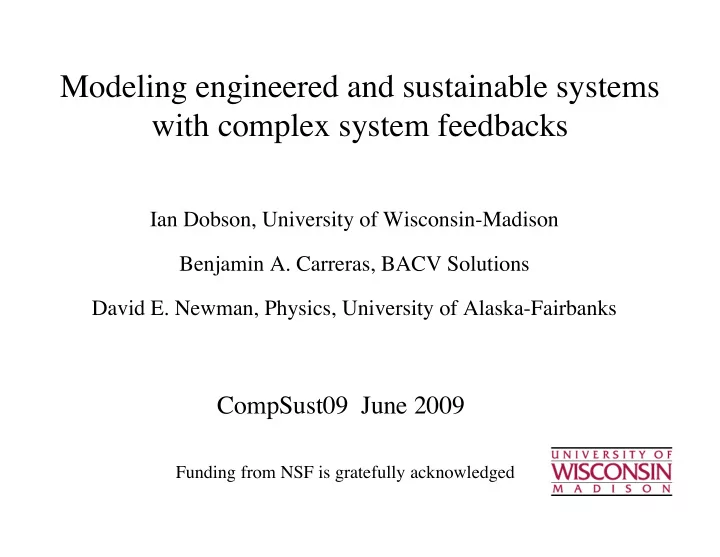

Modeling engineered and sustainable systems with complex system feedbacks Ian Dobson, University of Wisconsin-Madison Benjamin A. Carreras, BACV Solutions David E. Newman, Physics, University of Alaska-Fairbanks CompSust09 June 2009 Funding from NSF is gratefully acknowledged
Themes • Engineered infrastructure systems continually evolve and interact with society via feedbacks • Need to study evolving engineered systems, not arbitrary systems • In a sustainable infrastructures the evolution yields a “complex system steady state” • Properties can emerge from the complex system • There are challenges to model and compute the complex system steady state
Example of infrastructure: North American bulk power transmission system • Transmission network >30,000 Volt, meshed • Generators, transformers, transmission lines, bulk loads, protection, controls, operators. • Most of west (or east) of Rockies is connected together. • USA has roughly $ 900 billion invested. • Network size ~ >10,000 nodes or branches, 100 control centers
Electric grid continually evolves and interacts with society via feedbacks and drivers • Use of electricity increases at 2% a year, changes in population • Generation mix and locations changing, e.g. grid enables alternative energy • Engineering responses to changing demands • Engineering responses to blackouts • Engineering feedbacks strongly modulated by economics, finance, politics, ….
One blackout mechanism: Untrimmed trees cause line trip • too much power flow heats transmission line • line expands and sags, flashes over into untrimmed tree • protection device disconnects line • transient followed by a steady state redistribution of power flow to parallel paths. • line trips can cascade
Example of feedback • August 2003 northeastern blackout of 50 million people, cost roughly $8 billion • Some initial line failures in Ohio involved heavily loaded lines sagging into trees. • One of the responses to 2003 blackout is millions spent on tree trimming There are many other blackout mechanisms and feedbacks to regulate these after they occur in a blackout.
We need to study evolved or evolving power grids, not arbitrary grids Example: coordination of limits • Each transmission line, generator, etc. has a power flow limit • Limits must be coordinated to get maximum use of each component and return on investment. • Limits must be coordinated to mitigate cascading line overloads.
Methods to get grid models with coordinated parameters • Use real grid data (but problems of size, data access and confidentiality, and unwieldy) • Use fake or reduced grid, but do all the engineering (hard work) • Simulate the effect of the engineering on the fake or reduced grid by modeling the feedbacks shaping the system.
Simulating complex system dynamics and reaching steady state • Look at grid evolving subject to increasing load and engineering upgrades in response to blackouts. • Needs ability to simulate cascading blackouts … in this case the mechanism represented is cascading line overloads.
Feedback regulating reliability • Network slowly evolves in response to load growth (2% per year) and blackouts. • Higher loading causes more blackouts. • More blackouts causes network upgrade and in effect a reduced loading (what matters is loading relative to network capability). This is a socio/economic/engineering feedback. • The upgrade is a very simple principle: upgrade the lines involved in the last blackout; upgrade generation. That is, respond to failures by fixing the weakest parts!
118 node test grid
Exponential increase in load Load Time Load randomly varies around exponential trend
Selected line flow limits increasing in response to blackouts
Complex systems steady state: random variation but statistically stationary Fractional load shed Time Blackouts get bigger but fraction of load shed becomes stationary
Sustainability and complex systems dynamics • Existence of complex systems steady state is a necessary condition for sustainability and an attribute of sustainability • Also can judge whether the complex system steady state has desirable characteristics or interesting emergent properties. • Note that complex system steady state includes random variation
Power law emerges from complex system probability 10 2 Probabilty distribution 10 1 10 0 10 -1 U.S. grid data 382-node Network IEEE 118 bus Network 10 -2 blackout size 10 -4 10 -3 10 -2 10 -1 10 0 Load shed/ Power demand
Can evaluate and compare different policies for upgrade: same blackout sizes, but different utilization of system investment: Fractional line loading Gray is direct feedback Time Black is n-1 criterion
Modeling challenges • We have given one example of an evolving grid converging to a complex system steady state. • There is a huge modeling challenge to generally represent socio/econo/engineering feedbacks • Need to compromise model detail to get computational tractability • Feedback modeling more critical than detailed modeling of infrastructure (guideline by analogy with control theory) • Much more complicated to model feedbacks and evolving infrastructure, but simplicity can sometimes emerge in complex systems steady state. (Power laws in distribution of blackout size in case of blackouts)
Computational challenges • Fixed grid modeling is already challenging. Enumeration of possible cascading failures beyond first few failures impossible … need ways to sample from huge numbers of rare and unlikely combinations of events. • The grid evolution requires much faster computation because many iterations required for convergence.
Themes • Engineered infrastructure systems continually evolve and interact with society via feedbacks • Need to study evolving engineered systems, not arbitrary systems • In a sustainable infrastructures the evolution yields a “complex system steady state” • Properties can emerge from the complex system • There are challenges to model and compute the complex system steady state
An explanation of power system operating near criticality Mean blackout size 25 sharply increases at Mean Blackout Size critical loading; increased 20 <Line outages> risk of cascading failure. 15 Strong economic and 10 engineering forces drive system to near critical 5 loading 0 -5 0.8 1 1.2 1.4 1.6 1.8 2 2.2 Load
Recommend
More recommend